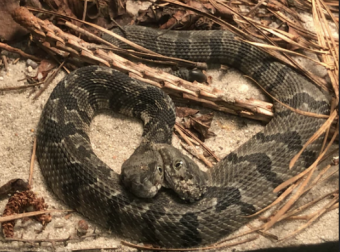Scientists have named a rare two-headed snake Double Dave after it was found in a forest in the US state of New Jersey.

The baby timber rattlesnake was discovered last month by environmentalists from the Herpetological Associates group, who study endangered and threatened reptiles.
The name Double Dave was coined because it was discovered by the environmentalist Dave Schneider and his colleague, also called Dave. The venomous pit viper, which is 20-25cm (8-10 inches) long, has two fully formed heads, meaning it has four working eyes and two flickering tongues.
Schneider explained that Double Dave’s two heads worked independently of each other, and it would be difficult for such a creature to survive in the wild, because the condition meant it was slow-moving and could be easily picked off by prey.
Two-headed snakes often have one head that is slightly more developed than the other, and the heads have been known to fight each other over food, not realising that whatever they eat is heading to the same digestive system.
The condition of having more than one head is known as polycephaly, and happens in much the same way that conjoined twins are formed: an embryo that has begun to split into identical twins stops before fully dividing.
Two-headed animals are considered in many cultures to be a portent of disaster, and they have frequently appeared in mythology. But although they are rare, happening in around one in 100,000 live births in the wild, two-headed snakes do turn up fairly frequently. In recent weeks, another two-headed snake made the news after it was photographed in the Bali resort of Tabanan.
In 2018, a two-headed snake even went on tour. Named Tom and Jerry, the 17-year-old California kingsnake appeared as one of the star attractions at the Reptile Expo in Villeneuve, Switzerland.
Keeping two-headed snakes alive can pose problems. Photographs of a two-headed eastern copperhead found in Woodbridge, Virginia, last year went viral, and the viper breeder Cooper Sallade, who was looking after it, told Wired magazine: “Since the snake had such an incomprehensible amount of media attention, there was a lot of pressure on me to keep that thing alive.”
He ended up gently force-feeding it, because the heads were not well-developed enough to eat independently, but after a few months the snake died.
Because of its poor chances of surviving in the wild, Double Dave is being taken into captivity by the Herpetological Associates. “We’ll take care of it,” said Schneider.
Source: Guardian



